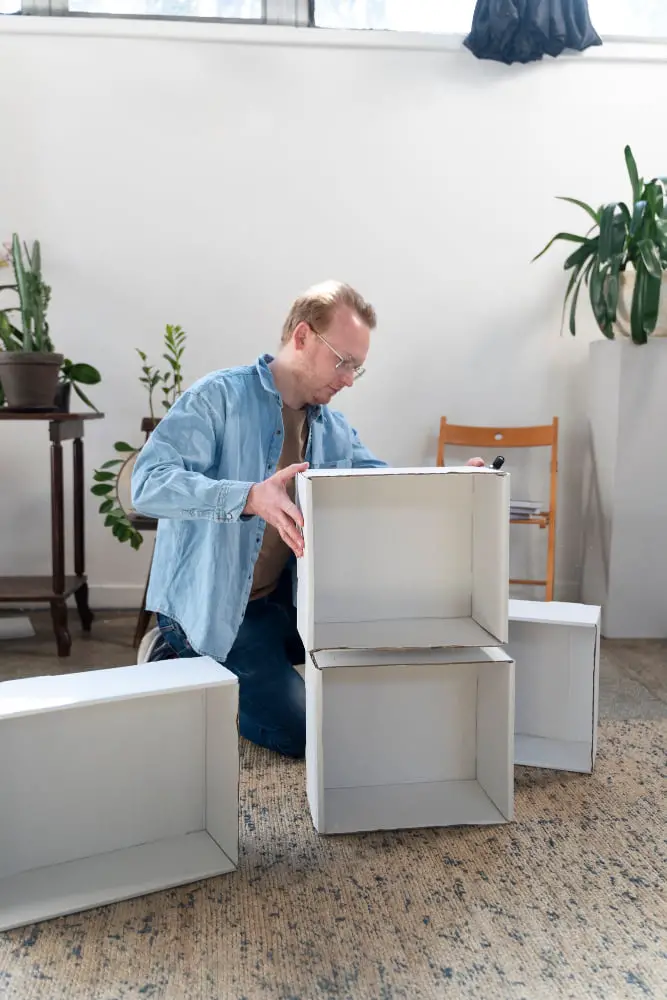Last updated on
Discover effective ways to declutter your life through these proven rules that can transform chaotic spaces into organized, functional and serene environments.
Decluttering can be a daunting task, but with a few simple rules, it can be transformed into a manageable and even enjoyable process.
This article will guide you through the essential principles of decluttering, from categorizing items and setting priorities, to establishing a routine and maintaining a clutter-free space.
Each rule provides a practical step towards achieving a tidier, more organized home.
Read on to discover how these rules can help streamline your decluttering journey, ensuring you have all the details needed to create a serene and clutter-free living environment.
Key takeaways:
- Decluttering is the targeted elimination of surplus or disorganized items.
- Follow rules to simplify decluttering and prevent future accumulation.
- Set tangible goals to guide the decluttering process.
- Assess the state of your clutter and prioritize areas of concern.
- Use the Four-Box Method for efficient sorting and decision-making.
Table of Contents
Understanding the Concept of Decluttering

Decluttering is a targeted elimination process involving the thoughtful removal of surplus, unneeded, or disorganized items from a space. It’s not merely about having less stuff, but rather about exercising control over your environment.
Through keeping only items that align with current needs, goals, or values, clarity and efficiency can be increased. By eliminating superfluous objects, you can shift focus toward items that enhance your home’s comfort and functionality.
The overall objective is a harmonious balance where everything has its designated place and serves a particular purpose.
Why You Need Rules for Decluttering

Adhering to a set of guidelines simplifies the decluttering process by providing systematic steps to follow, thereby eliminating the overwhelm often associated with large tasks. Each rule serves as a road map to avoid getting lost in the clutter, guiding you to distill the essentials from the unnecessary.
These guidelines also ensure you make consistent decisions, prevent future accumulation of clutter, and maintain an organized and harmonious environment, ultimately helping to transform decluttering from an occasional event to a sustainable, long-term habit.
Determining Your Decluttering Goals

Ascertain tangible and realistic objectives to help guide the process. A clear vision might be ‘to create a space that allows easy access to daily necessities’ or ‘free up room for a home office‘. These goals provide direction and motivation, propelling the decluttering progress and making overwhelming tasks manageable.
Remember, each individual’s end point of decluttering is different – it’s about creating a space that optimizes functionality without causing undue stress or confusion.
Assessing the State of Your Clutter

An initial assessment can work wonders in laying a solid foundation for your decluttering project. Begin by examining each room in your home, pinpointing areas of concern.
Take note of the items that have accumulated over time, especially those untouched for over a year.
Review this inventory objectively, already considering which items might be unnecessary or duplicates.
This crucial step helps form a vivid picture of the task ahead, aids prioritization, and stimulates actionable strategies.
Remember, the goal is to be honest and comprehensive during this evaluation phase as it directs the trajectory of your decluttering journey.
The Four-Box Method

This method simplifies the decluttering process and helps in making quick, effective decisions regarding every item.
Prepare four labelled boxes for sorting: Keep, Donate/Sell, Trash, and Undecided.
You’ll need to assess, without exception, each item in your clutter and allocate it to one of the boxes.
Be honest. If it’s unused or no longer needed, it goes into the ‘Donate/Sell’ or ‘Trash’.
Items that still serve you can be kept, while those requiring further deliberation go into the ‘Undecided’ box.
It’s crucial to revisit this box regularly, ideally within a few days.
Long pauses create room for indecisiveness, reducing the method’s efficacy.
The ongoing cycle of sorting helps develop a habit of regular decluttering, managing clutter before it accumulates.
Remember: it’s okay to let things go. By simplifying your belongings, you simplify your life.
Creating a System of Organization

Begin by segregating items into categories. This might be by room, by type, or by function depending on what makes sense for your lifestyle. From there, allocate a defined space for each category, ensuring that everything has a ‘home’. Label storage spaces for easy identification and retrieval.
Implement use of containers, shelves or digital tools that might aid your system.
Keep the most frequently used items within easy reach. Sequentially arrange items of the same category, for example, clothes can be arranged by type or color. Follow a system that resonates with your daily routine for it to be effective long-term. Over time, this system will become second nature and contribute towards maintaining a clutter-free space.
Remember, an organizational system needs to be flexible. It should be adaptable to changing life circumstances or variations in the volume of items. Review and amend your system periodically to ensure it continues serving its purpose.
Tackling One Area At a Time

It’s essential to prevent feel overwhelmed during the decluttering process. Set a manageable goal, such as focussing on a single shelf, a drawer, or a corner of a room.
By narrowing your focus, the task becomes achievable and you’ll see tangible progress quickly. Beginning with smaller areas can also boost your confidence, making it easier to approach larger cluttered spaces with a strategy and a positive outlook.
Remember to finish completely before moving on to the next area. This includes sorting, discarding, organizing and cleaning each area.
This approach ensures a thorough decluttering process, reducing the chances of reverting to cluttered spaces.
Strategies for Decluttering Clothes

Begin with grouping your clothes by type: pants, shirts, dresses, and so on. Assess each item objectively, examining them for signs of wear or damage. Consider the last time you wore each piece.
A common rule of thumb is to discard anything unworn in the last year, unless it holds significant sentimental value.
Next, think about your personal style and the usefulness of each item in your wardrobe. If the piece doesn’t align with your current taste or it’s not serving a specific purpose, donate or sell it.
Exercise discipline to avoid the “I may need it someday” trap. For items you’re unsure about, try the ‘hanger trick’. Place these clothes on hangers and reverse the hanger direction.
If after six months, the hanger is still reversed, it’s a clear sign you should part with the piece.
Finally, for efficient organization, try the vertical folding method to save space and keep your clothes visibly organized. Sort them by color or type, whichever works best for you. Remember, the goal is not just to declutter, but also to create a system that makes dressing up easier and enjoyable.
Dealing With Sentimental Items

Handling items imbued with emotional value or nostalgia can present quite a challenge. To successfully navigate this aspect of decluttering, start by designating a special box for these items. Limit the number to avoid overcrowding – a clear parameter is essential.
Closely examine each sentimental item. If it brings a wave of happiness or a cherished memory, and you have space, consider keeping it. However, if it invokes feelings of guilt, regret, or sadness, it is likely better to let it go.
Consider digitalizing photos and letters, enabling preservation while freeing up physical space. For larger items like furniture, evaluate if it serves a purpose and fits your home’s aesthetic. If not, taking a photograph might be sufficient to hold onto the memory.
Remember, decluttering does not mean erasing the past. It’s about making space for the present and the future. Deciding to part with a sentimental item doesn’t diminish its value or its associated memories.
Making Decisions: Keep, Donate, or Trash?

When analyzing items, it’s crucial to make unbiased decisions. Consider each item’s value, usefulness, and sentimentality.
If it’s no longer needed or used but in good condition, donating provides an excellent chance to give it a second life in a new home.
Items that no longer serve a purpose due to their condition should be trashed or recycled where possible.
With items you decide to keep, placement and organization become essential. Ensure they have a designated spot in your home, optimally one that fits into your existing system of organization.
This decision-making process forms a significant part of decluttering and serves as the basis for maintaining an organized living space.
Paperwork: What to Keep, What to Toss

When sifting through stacks of paper, it’s crucial to know what documents are worth keeping. Necessary documents include tax returns, property records, significant contracts, and any official certificates or licenses; keep these in a safe, accessible area.
A general rule of thumb for financial statements or medical records is to retain them for at least seven years.
For less important paperwork, such as pay stubs or bank statements, consider switching to digital versions to reduce paper clutter.
Anything outdated, like old utility bills or expired insurance policies, can be discarded. However, always remember to shred any paperwork that contains sensitive information to avoid potential identity theft.
By following these guidelines, it becomes easier to separate the essential papers from the nonessential, helping keep your space clutter-free.
The Role of Functionality in Decluttering

In decluttering, weighing the functionality of an item plays a critical part. An object that’s frequently used holds more value compared to one that’s rarely touched. If an item is not contributing towards the overall functionality of your home, consider removing it.
This applies to duplicates as well; if you have multiples of the same item, it might be time to let some go. However, remember, decluttering isn’t about minimalism exclusively, but more about efficiency and ease-of-use. It is essential to ensure that the items in your space serve a purpose and contribute positively to your lifestyle.
Overcoming Wasting Fears in Decluttering

Frequently, fear of waste comes from the mindsets of scarcity or guilt. You might worry about needing an item in the future or feel guilty about letting go of gifts. However, it’s important to challenge these thoughts.
Holding onto items “just in case” can lead to accumulation of more clutter. Distinguish between actual use and potential use. If an item hasn’t been useful in recent years, it’s unlikey its moment will come.
As for guilt-centered items, keep in mind that the joy in receiving is in that moment; you shouldn’t feel obligated to keep gifts forever. The priority is your peaceful, decluttered space.
Ultimately, shifting your mindset can help ease these fears leading to making more decisive decluttering choices.
Avoiding Distractions During Decluttering

To maintain a productive decluttering session, proactive measures to minimize interruptions prove crucial.
Designate a specific time for decluttering, just as any other important activity in your schedule. Avoid phone calls, social media, and television during this period.
If possible, ask other members of the household to support you by not interfering during your scheduled decluttering time.
Remember, a focused session of 30 minutes can yield more results than hours of distracted effort. Creating a quiet, disturbance-free environment aids concentration and boosts efficiency.
Maintaining a Decluttered Home

Adhering to an organization system is crucial for longevity in a decluttered space.
Scheduled routine checks are beneficial to prevent clutter from sneaking back into your space.
Whether it’s monthly or seasonally, set a consistent routine for reviewing your spaces, and adjust as needed.
Cultivate a habit of immediately placing things back where they belong following use, and consistently addressing incoming mail or paperwork.
Remember, fostering mindful consumption habits can prevent excessive accumulation of unnecessary items.
Prioritize quality over quantity by investing in fewer but more meaningful or functional items.
This maintenance mindset turns decluttering from a massive one-time task into a sustainable lifestyle.
FAQ
What is the 5 second rule for decluttering?
The 5-second rule for decluttering suggests that if you pick up an item and cannot recall when you last used it within five seconds, it should be removed, excluding sentimental objects.
What is the rule of 5 decluttering?
The rule of 5 decluttering is a method which involves getting rid of at least five items in every room when embarking on a decluttering activity.
What is the 20 rule decluttering?
The 20/20 rule in decluttering advocates for letting go of an item if it can be replaced for less than $20 and within less than 20 minutes.
What is the 12-12-12 rule for decluttering?
The 12-12-12 rule for decluttering involves identifying 12 items to throw away, 12 items to donate, and 12 items to be returned to their designated places.
What is the significance of the Four-Box Method in decluttering?
The Four-Box Method in decluttering helps categorize unnecessary items into four boxes: keep, trash, donate, and relocate, promoting simplicity, organization, and effective item management.
How does the KonMari Method streamline the decluttering process?
The KonMari Method streamlines the decluttering process by guiding individuals to categorize their belongings into five groups and discard those items that do not ‘spark joy,’ making tidying a mindful, intentional process.
In what ways does the 90/90 Rule influence decisions during decluttering?
The 90/90 Rule, which advises removal of items not used in the past 90 days and unlikely to be used in the next 90, helps make decluttering decisions by injecting a useful timeframe for assessing the practical necessity of items.




